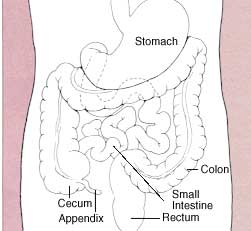Difference Between Small Intestine and Large Intestine
 Small Intestine vs Large Intestine
Small Intestine vs Large Intestine
The intestines of the human body can be divided into two ‘“ the small intestine and the large intestine. However, the small intestine and large intestine are continuous tubes with differing functionalities as well as structural appearances. Both the small intestine and the large intestine are fragments of the alimentary canal or digestive tract. The digestive or alimentary tract is an elongated and continual tube like structure that begins in our mouth and reaches up to the rectal area. The digestive tract comprises the pharynx, mouth, stomach, esophagus, the small intestines and large intestines and finally the rectum.
The smaller intestine is also referred to as the small bowel and it is an elongated tube that helps in the passage of the food that comes from our stomach. The large intestine happens to be the place where the stool accumulates. The small intestine contains a large part of the ingredients that we consume or digest, as the nutrients are passed off to the body for use. On the other hand, our large intestine comprises fluids and undigested substances.
The smaller intestine can be subdivided into secondary components like the duodenum, jejunum and the ileum. Once the nutrients are absorbed by the body to be used up as food, the particles are moved on into the large intestine for being converted into waste matter. The large intestine contains 4 main components such as the colon, cecum, canal and rectum. While the focus of the small intestine is to convert food particles into nutrients, the large intestine involves in multiple functions.
The vitamins B and K are generated in our large intestine by benign bacteria that are found there. Secondly, the organ helps in water retention, as well as absorption of irons and salts. Finally, the large intestine aids in bowel movement which is the remains of the digested food that is passed out into the anal area in the form of stool.
Summary:
1. The small intestine is a component of the alimentary canal or gastro intestinal tract that is smaller than the large intestine, which forms a major part of the gastro intestinal tract.
2. The function of the small intestine involves drawing in the nutrients from food particles, whereas large intestine is responsible for converting the food particles thus passed off into waste.
3. The small intestine mixes food with chemicals for digestion, whereas the primary aim of our large intestine is to eliminate water.
- Difference Between Fish and Reptiles - August 10, 2011
- Difference Between Xeon and i7 - January 7, 2010
- Difference Between GPS and AGPS - December 20, 2009

Is the usage of continuous and continual right here? I have my doubts about it.